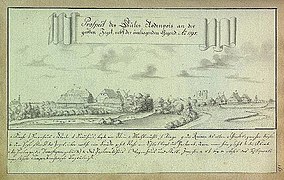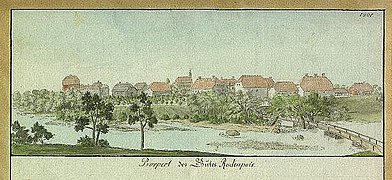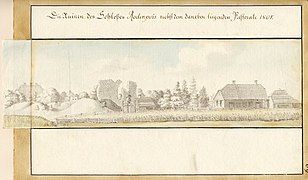Rodenpois Castle
| Rodenpois Castle | ||
|---|---|---|
|
Ruins of the Rodenpois Castle today |
||
| Alternative name (s): | Ropažu viduslaiku pils | |
| Creation time : | 1320 to 1322 | |
| Castle type : | Niederungsburg | |
| Conservation status: | ruin | |
| Construction: | granite | |
| Place: | Ropaži | |
| Geographical location | 56 ° 58 '43.3 " N , 24 ° 37' 51.2" E | |
|
|
||
Rodenpois Castle ( Latvian Ropažu viduslaiku pils ) is the ruins of an order castle of the Livonian Order in Ropaži in Latvia near Riga on the right bank of the Great Jägel ( Lielā Jugla ) on the old road from Salaspils ( Kirchholm ) to Sigulda ( Segewold ).
Castle description
The castle was built on an old castle hill, the south and west of which consisted of the 6 to 10 meter high banks of the Große Jägel. Up to 1.5 meters thick masonry walls were built from granite blocks . They formed an irregular hexagon with a body on the river bank. Only two fragments of masonry have survived, the largest of which is 13 m long and 5 m high. In 2011, archaeological excavations revealed previously unknown defensive walls of the castle.
history
Heinrich's Livonian Chronicle mentions the place Rodenpois as early as 1205, when in the Battle of Rodenpois ( bellum cum letonibus in Rodopoyse ) order troops under Konrad von Meyendorp together with Semgallic fighters under King Westhard defeated a Lithuanian army returning from Estonia with rich booty.
In order to block the access to Riga between the Jägelsee and Kirchholm Castle ( Salaspils ), the Order of the Brothers of the Sword built a fortification between 1320 and 1322 on the site of the former Livian castle hill. Castle Rodenpois was part of a chain of castles along the Livonian Aa ( Gauja ) against attacks Lithuanian troops from the castles Rodenpois - Castle Lemburg ( Mālpils viduslaiku pils ) - Nitau ( Nitaures pils ) - Jürgensburg ( Zaubes pils ) - Neuchâtel ( Jaunpils ) and Schujen ( Skujenes pils ) existed.
After the division of Livonia by the papal legate William of Modena , Rodenpois was transferred to the control of the Livonian Order in 1237.
In connection with the disputes between the city of Riga and the Teutonic Order , the order won a victory on June 29, 1298 in the Battle of Neuermühlen near Rodenpois. During the Livonian civil war, troops of the order besieged the city of Riga in 1491 and burned down Rodenpois Castle.
When the monastic state was dissolved, Rodenpois came into possession of Baron Heinrich von Dohna together with Nitau, Neuermühlen, Allasch and Indasch. The castle was later assigned to the diocese of Wenden and then returned to private ownership.
During the First Northern War around 1559 to 1560, the Russian army burned Rodenpois Castle. The castle must have been repaired soon, as it was handed over to the Swedes in 1601, so it was in good condition. Axel Oxenstierna bequeathed the castle to his son Erich in 1650.
Engravings by Johann Christoph Brotze (* 1742)
proof
- ↑ iespējams, atrakta daļa Ropažu pils aizsargmūra. Retrieved August 5, 2019 .
- ^ Leonid Arbusow: Outline of the history of Liv, Estonia and Courland . Jonck and Poliewsky, 1918, p. 21 .
- ↑ Otto von Rutenberg: History of the Baltic provinces of Liv, Esth and Kurland from the earliest times to the decline of their independence . tape 2 . Engelmann, 1860.
- ^ A b Karl Woldemar von Löwis of Menar: Burgenlexikon für Alt-Livland . Walters and Rapa, Riga 1922, p. 103 ( digitized version ).
- ^ Armin Tuulse: The castles in Estonia and Latvia (= negotiations of the Estonian learned society . Volume 33 ). Õpetatud Eesti Seltsi Toimetused, S. 242 .





